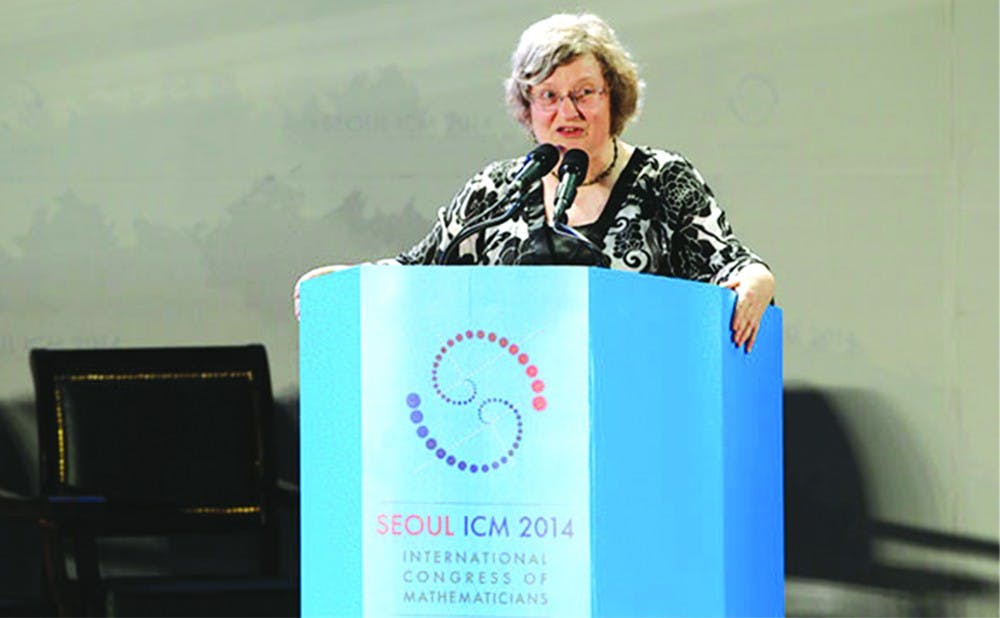Duke undergraduates know professor Ingrid Daubechies as an instructor of multivariable calculus, but beyond Duke, she has become famous for her study of wavelets, or mathematical functions with the ability to enhance image compression technology.
Daubechies, a Belgian James B. Duke professor of mathematics and electrical and computer engineering, came to Duke in 2010 after being on faculty at Princeton University, and she served as the first female president of the International Mathematical Union from 2011 to 2014. Daubechies’ work in applied mathematics is well-known, particularly in regard to the “Daubechies wavelets”—which are integral to the JPEG image compression format.
“Wavelets are a mathematical tool,” she explained. “They are like little elementary building blocks to expand images into.”
Daubechies’ wavelets can be used to summarize and compress images. In most pictures, pixels look very similar to their neighbors, and pixels that are very different from their neighbors are a minority, she said. Storing each individual pixel takes much more effort and memory than using a tool—like wavelets—to show that there is not something new happening for each pixel you encounter.
Daubechies is also a graduate student advisor, and her advisees explained that her work in wavelets has been highly influential.
“From a student’s perspective, almost every theorem in wavelets has the Daubechies name attached to it,” said Shan Shan, a second-year graduate student in mathematics.
Shan is currently surveying the literature on signal processing, a field in which wavelets are an important tool, noted Rachel Yin, another one of Daubechies’ Ph.D. advisees.
In addition to image compression, wavelets can also be used as a tool to help detect art fraud, Daubechies said, although she emphasized that mathematical tools alone may not be enough to identify counterfeit paintings.
“If you have a style you’re comfortable with, your brush strokes will look different and actually leave a trace when you start looking at these building blocks of the image than if you tried to copy or imitate the style,” she explained.
Daubechies’ work focuses on both applied and interdisciplinary implications of her mathematical research.
“She’s really at the frontier of applied mathematics,” Yin said.
Yin also noted Daubechies’ interdisciplinary work with the biology department at Duke and her connections with art museums. Daubechies is currently collaborating with the North Carolina Museum of Art for a 14th century art restoration exhibition—“Reunited: Francescuccio Ghissi’s St. John Altarpiece”—to give viewers an idea of how the paintings must have looked when new.
Daubechies’ students added that they felt she was very open-minded and pushed her students to be independent thinkers.
“She’s very encouraging of different mathematical thought,” said Tingran Gao, a visiting assistant professor of mathematics and former advisee of Daubechies. “She doesn’t want her prior knowledge to interfere with our own logical reasoning.”
Yin agreed, noting that Daubechies would not “push [you] very hard onto some project that you’re not interested in.”
Shan added that she felt like she could ask “stupid” questions without judgment, and that Daubechies always had words of encouragement and a great sense of humor.
Daubechies has also been involved in speaking out against academic publishers. She said she is concerned about the monopoly that scientific publishers hold over academia and how they exploit it to make “enormous profits.” Although she recognizes that publishers owe their shareholders profits, Daubechies said she still feels that their journals charge at exploitative rates.
“We feel it’s not fair in a business where we [academics] provide the content, the editorship, the reviewing of the papers and the readership,” Daubechies said, noting that editors and reviewers are unpaid. “[Editors and reviewers] do this as volunteering for our community—we don’t need to be [paid]. But then we feel that the community should not have to pay the enormous prices.”
Daubechies also teaches undergraduate courses, including multivariable calculus.
“I liked being in her class,” junior Daniel Zhu said. “She seemed like she was actually interested in teaching and it’s really cool to be taking a class with someone who’s a leader in the field.”
Daubechies’ enthusiasm for working with students—both undergraduate and graduate—mirrors her enthusiasm behind her multidisciplinary research.
“I like to work with people who have problems that they’d like to figure out and where I can detect a mathematical aspect to it,” Daubechies said.

